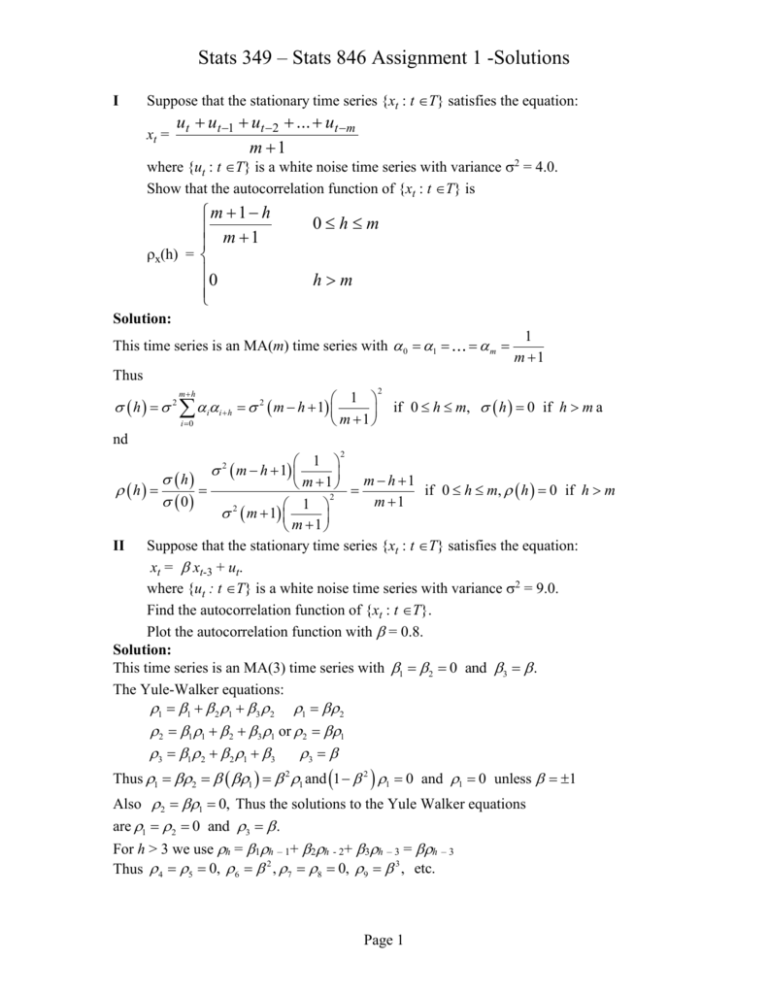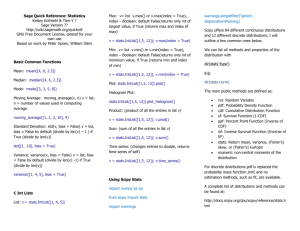Solution
advertisement

Stats 349 – Stats 846 Assignment 1 -Solutions
I
Suppose that the stationary time series {xt : t T} satisfies the equation:
xt =
ut ut 1 ut 2 ... ut m
m 1
where {ut : t T} is a white noise time series with variance 2 = 4.0.
Show that the autocorrelation function of {xt : t T} is
m 1 h
m 1
x(h) =
0
0hm
hm
Solution:
This time series is an MA(m) time series with 0 1
m
1
m 1
Thus
h
mh
2
i 0
i
ih
1
m h 1
m 1
2
2
if 0 h m, h 0 if h m a
nd
2
1
h
m 1 m h 1 if 0 h m, h 0 if h m
h
2
0
m 1
1
2
m 1
m 1
II Suppose that the stationary time series {xt : t T} satisfies the equation:
xt = xt-3 + ut.
where {ut : t T} is a white noise time series with variance 2 = 9.0.
Find the autocorrelation function of {xt : t T}.
Plot the autocorrelation function with = 0.8.
Solution:
This time series is an MA(3) time series with 1 2 0 and 3 .
The Yule-Walker equations:
1 1 2 1 3 2 1 2
2 m h 1
2 11 2 3 1 or 2 1
3 1 2 2 1 3
3
Thus 1 2 1 2 1 and 1 2 1 0 and 1 0 unless 1
Also 2 1 0, Thus the solutions to the Yule Walker equations
are 1 2 0 and 3 .
For h > 3 we use h = 1h – 1+ 2h - 2+ 3h – 3 = h – 3
Thus 4 5 0, 6 2 , 7 8 0, 9 3 , etc.
Page 1
Stats 349 – Stats 846 Assignment 1 -Solutions
Plot of autocorrelation function:
1.2
1
0.8
0.6
0.4
0.2
40
38
36
34
32
30
28
26
24
22
20
18
16
14
12
10
8
6
4
2
0
0
III. Consider the Autoregressive (AR(3)) process of order 3 satisfying the equation:
xt= 1xt-1 + 0.25xt-2 - 0.10xt-3+ + ut where var(ut) = 2.
Suppose that the autocorrelation function, (h), at lag h = 1 takes on the values
(1) = 0.50. In addition var(xt) = 10 and E[xt] = = 25
a) Determine the values of 1, and 2 .
Solution This is an AR(3) time series with 1 (unknown), 2 = 0.25 and 3 = 0.10.
The Yule-walker equations are
0.5 1 0.25 0.5 0.10 2
1 1 2 1 3 2
2 11 2 3 1 or 2 1 0.5 0.25 0.10 0.5
3 1 2 2 1 3
3 12 0.25 0.5 0.10
The first two equations can be used to solve for 1 and 2.
1 0.375 0.102 and 2 0.51 0.30 0.5 0.375 0.10 2 0.30
0.4875
0.46429
1.05
and 1 0.375 0.102 0.375 0.10 0.46429 0.32857
1.05 2 0.5 0.375 0.30 0.4875 and 2
Finally 25
1 2 3 0.32857 0.25 0.10 0.32143
and 0.32143 25 8.036
Now 1 0.5, 2 0.46429 . The third equation of the Yule-Walker equations can be
used to calculate 3. Namely
3 12 2 1 3 0.32857 0.46429 0.25 0.50 0.10 0.377551
Page 2
Stats 349 – Stats 846 Assignment 1 -Solutions
To compute 2 we use
10.0 0
2
1 1 1 2 2 3 3
2
1 0.32857 .5 0.25 0.46429 0.10 0.377551
2
0.681888
Thus 10.0 0.681888 6.81888
2
b) Compute and plot a graph of (h), the auotocovariance function of the process
at lag h, for h = 0, 1, 2, 3, 4.
Solution:
For h >3 we use h 1h1 2 h2 3 h3 0.32857 h1 0.20h2 0.10h3
Thus 4 0.32857 0.377551 0.25 0.46429 0.10 0.5 0.290124
Finally
The autocovariance function is determined by (h) = (0) h= 10.0 h
Thus (0)=10.0, (1) = 5.0, (2) = 4.6429, (3) = 3.77551, (4) = 2.90124
IV.
An AR(2) time series, {xt : t T}, if | r1 | >1 and | r2 | >1, where r1 and r2 are the
roots ofthe polynomial 1 -1 x - 2x2 = 0. Show that an AR(2) time series is
stationary if the parameters, 1 and 2, satisfy the following inequalities:
2 + 1 < 1,
2 - 1 < 1,
-1 < 2 < 1.
2
Show that roots r1 and r2 are complex if 1+ 4 2 < 0.
Graph this regions implied by these inequalities.
Solution:
x
1 1 1 2
x
1 1 x 2 x 2 1 1 1 x
x where
r1 r2
r1 r2 r1r2
1 4 2
r1 , r2
are the roots of 1 1 x 2 x 2
2 2
Note: r1 , r2 are complex if 4 2 0 Also 1
1 1
1
1
and 2
, , 2
r1 r2
r1r2
r1 r2
1 1 1 1 1
1 1
r1 r2 r1r2 r1 r2
1 1 1 1 1
and 1 2 1 1
1 1
r1 r2 r1r2 r1 r2
1
Now 2
1 , 1 1 2 0 and 1 2 1 0 if and only if r1 1 and r2 1
r1 r2
Thus 1 1 2 1
Page 3










